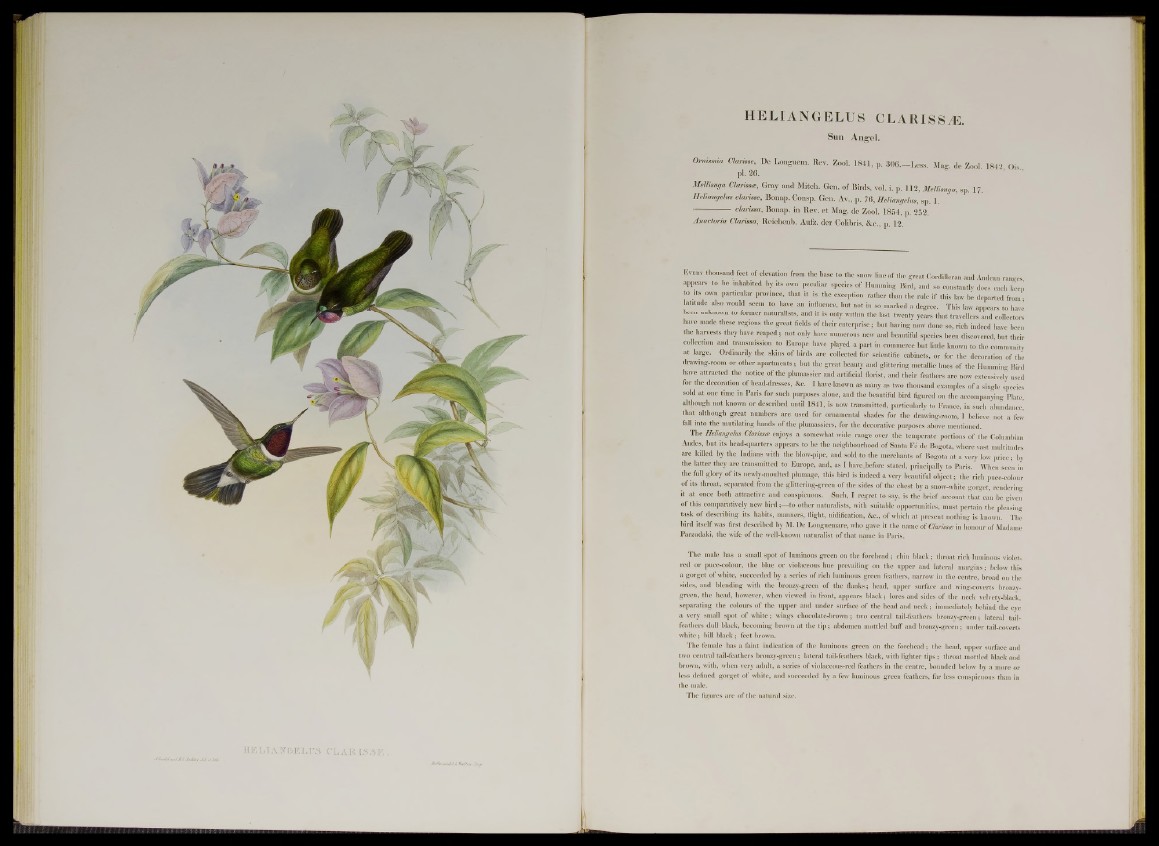
HELIANGELUS CLARIS SA.
Sun Angel.
Omismia Clarme, De Longuem. Rev. Zool. 1841, p. 306.— Less. Mag. de Zool 1842 Ois
pi. 26.
Mellimga Clarissa, Gray and Mitch. Gen. of Birds, vol. i. p. 112, Mellimga, sp. 17.
Heliangelm clarisse, Bonap. Consp. Gen. Av„ p. 76, Heliangelm, sp. 1.
------------------darissa, Bonap. in Rev. e t Mag. de Zool. 1854, p. 252.
Anactoria Clarissa, Reichenb. Aufz. der Colibris, &c., p. 12.
Evsey thousand feet of elevation from the base to the snow line of the great Cordilleran and Andean ranges
appears to he inhabited by its own peculiar species of Humming Bird, and so constantly does each keep
to its own particular province, that it is the exception rather than the rale if this law be departed from ■
latitude also would seem to have an influence, but not in so marked a degree. This law appears to have
been unknown to former naturalists, and it is only within the last twenty years that travellers and collectors
have made these regions the great fields of their enterprise; but having now done so, rich indeed have been
the harvests they have reaped; not only have numerous new and beautiful species been discovered, but their
collection and transmission to Europe have played a part in commerce but little known to the community
at large. Ordinarily the skins of birds are collected for scientific cabinets, or for the decoration of the
drawing-room or other apartments; but the great beauty and glittering metallic hues of the Humming Bird
have attracted the notice of the plumassier and artificial florist, and their feathers are now extensively used
for the decoration of head-dresses, &c. I have known as many as two thousand examples of a single species
sold at one time in Paris for such purposes alone, and the beautiful bird figured on the accompanying Plate,
although not known or described until 1841, is now transmitted, particularly to France, in such abundance!
that although great numbers are used for ornamental shades for the drawing-room, I believe not a few
fall into the mutilating hands of the plumassiers, for the decorative purposes above mentioned.
The Heliangelm Clarissa enjoys a somewhat wide range over the temperate portions of the Columbian
Andes, but its head-quarters appears to be the neighbourhood of Santa Fe de Bogota, where vast multitudes
are killed by the Indians with the blow-pipe, and sold to the merchants of Bogota at a very low price; by
the latter they are transmitted to Europe, and, as I have.before stated, principally to Paris. When seen in
the full glory of its newly-moulted plumage, this bird is indeed a veiy beautiful object; the rich puce-colour
of its throat, separated from the glittering-green of the sides of the chest by a snow-white gorget, rendering
it at once both attractive and conspicuous. Such, I regret to say, is the brief account that can be given
of this comparatively new bird;—to other naturalists, with suitable opportunities, must pertain the pleasing
task of describing its habits, manners, flight, nidification, Ac., of which at present nothing is known. The
bird itself was first described by M. De Longuemare, who gave it the name of Clarissa in honour of Madame
Parzudaki, the wife of the well-known naturalist of that name in Paris.
The male has a small spot of luminous green on the forehead; chin black; throat rich luminous violet-
red or puce-colour, the blue or violaceous hue prevailing on the upper and lateral margins; below this
a gorget of white, succeeded by a series of rich luminous green feathers, narrow in the centre, broad on the
sides, and blending with the bronzy-green of the flanks; head, upper surface and wing-coverts bronzy-
green, the head, however, when viewed in front, appears black; lores and sides of the neck velvety-black,
separating the colours of the upper and under surface of the head and neck; immediately behind the eye
a very small spot of white; wings chocolate-brown; two central tail-feathers bronzy-green; lateral tail-
feathers dull black, becoming brown at the tip ; abdomen mottled buff and bronzy-green; under tail-coverts
white; bill black; feet brown.
The female has a faint indication of the luminous green on the forehead; the head, upper surface and
two central tail-feathers bronzy-green; lateral tail-feathers black, with lighter tips; throat mottled black and
brown, with, when very adult, a series of violaceous-red feathers in the centre, bounded below by a more or
less defined gorget of white, and succeeded by a few luminous green feathers, far less conspicuous than in
the male.
The figures are of the natural size.